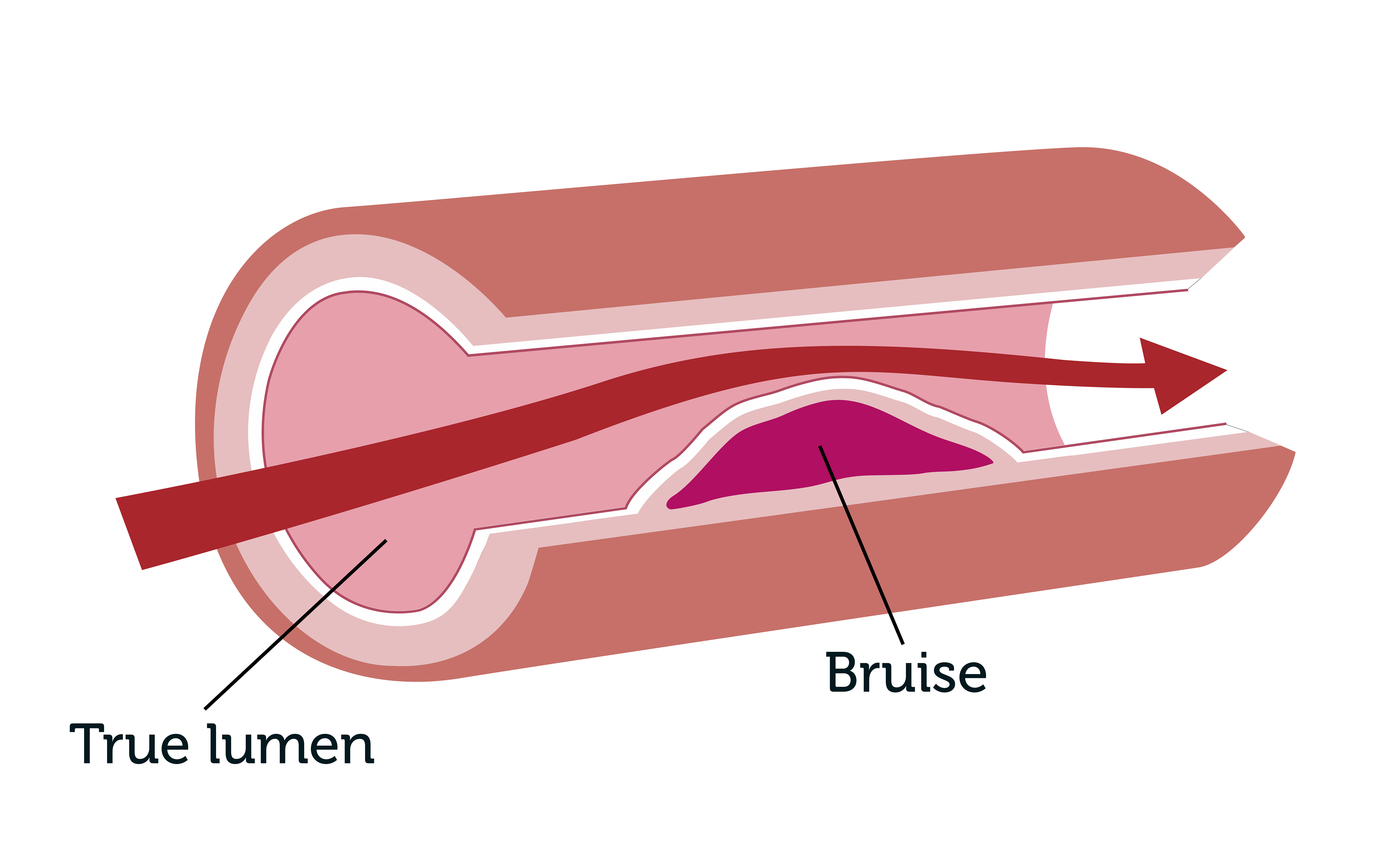What is SCAD?
Spontaneous Coronary Artery Dissection (SCAD) is an uncommon heart condition where a false lumen develops in the wall of a coronary artery which extends, compressing the true lumen, resulting in a blockage or narrowing that prevents normal blood flow. This leads to a heart attack and occasionally heart failure or cardiac arrest which, rarely, can be fatal.

The cause of false lumen formation is unclear but growing evidence suggests that micro-vessels within the artery wall haemorrhage, creating a bruise (called an intramural haematoma), which causes vessel narrowing and sometimes ruptures to form a dissection flap.
Click here to download our information sheet explaining what we think happens during a SCAD.
SCAD Explained
What is SCAD? Update from our Conference October 2023
Symptoms
SCAD usually presents as Acute Coronary Syndrome (ACS) so you’re looking out for ‘the usual’ symptoms ie some or all of:
- central chest pain or discomfort
- arm pain or numbness
- pain in the jaw, back or shoulders
- nausea and vomiting
- diaphoresis (excessive sweating)
- dyspnoea (shortness of breath)
Patients with SCAD are more likely to be young, female and may have fewer risk factors than atherosclerotic ACS patients. In this context atypical presentations are more common and a lower threshold should be used for high sensitivity Troponin assessment.
Many SCAD patients are misdiagnosed or their symptoms dismissed. Here's some advice for healthcare professionals from SCAD patients who had their SCADs around the time of pregnancy.
Listen to this Medics 4 Rare Diseases podcast where Beat SCAD and Dr David Adlam, who is leading the UK research, discuss issues surrounding diagnosis.
More research is needed to understand why fit, healthy people suddenly develop SCAD.
Associated conditions
Many SCAD patients have other conditions, such as Fibromuscular Dysplasia so a head-to-hip scan is recommended to diagnose or rule out these conditions.
SCAD Facts
- ~90% of SCAD patients are female, about 10% are male
- ~10% of SCAD patients will have more than one SCAD
- SCAD has been reported in patients aged 18-84, but most patients are in young to middle-age with the average age around 50 years. All ethnicities may be affected
- SCAD accounts for up to 4% of all Acute Coronary Syndromes (ACS) but incidence is reported to be much higher in women who are
- under 60
- have pregnancy-related heart attacks (particularly in the first 6-months post partum) (see Pregnancy and Spontaneous Coronary Artery Dissection: Lessons From Survivors and Nonsurvivors research paper)
- Pregnant/post-partum cases account for around 10% of cases of SCAD overall but
- SCAD accounts for 21-27% of heart attacks in pregnancy
- 50% of post-partum coronary events are reportedly due to SCAD
- Clinical presentations can vary considerably, but elevation of Troponin levels associated with chest discomfort is the most common
- SCAD patients have fewer risk factors than atherosclerotic ACS patients but some risk factors (particularly hypertension) may occur in SCAD patients
- SCAD is associated with abnormalities of the extra-coronary arterial beds including fibromuscular dysplasia (FMD), aneurysms and dissections
- SCAD is associated with a risk of recurrence. 10% of SCAD patients will have a further event within 5-10 years of their first SCAD. Multiple recurrences may occur in some patients
- SCAD generally has a good prognosis despite the recurrence risk
Resources
2023 ESC Guidelines for the management of acute coronary syndromes (SCAD details on pages 49-50, section 9.3).
2020 ESC Guidelines for the management of acute coronary syndromes in patients presenting without persistent ST-segment elevation (SCAD details on pages 37-38 section 6.1.5).
Spontaneous coronary artery dissection: contemporary aspects of diagnosis and patient management
PCR-EAPCI Textbook Percutaneous Interventional Cardiovascular Medicine (David Adlam, Fernando Alfonso, Angela Maas, Alexandre Persu, Christiaan Vrints, PCR Online, published May 2021)
European Society of Cardiology, acute cardiovascular care association, SCAD study group: a position paper on spontaneous coronary artery dissection (David Adlam, Fernando Alfonso, Angela Maas, Christiaan Vrints, European Heart Journal, published 21 September 2018)
All medical information on this site has been approved by Dr David Adlam, Professor of Acute and Interventional Cardiology, University of Leicester, Cardiovascular Research Centre at Glenfield General Hospital, Leicester. Dr Adlam is leading the UK SCAD research project.
